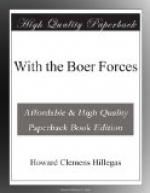The men who fought with the Boers because they were deeply in sympathy with the Republican cause were in far greater numbers than those with other motives, and their services were of much value to the federal forces. The majority of these were in the country when the war was begun, and were accepted as citizens of the country. They joined commandos and remained under Boer leaders during the entire campaign. In the same class were the volunteers who entered the Republics from Natal and Cape Colony, for the purpose of assisting their co-religionists and kinsmen. Of these there were about six thousand at the beginning of hostilities, but there were constant desertions, so that after the first six months of the war perhaps less than one-third of them remained. The Afrikanders of Natal and Cape Colony were not inferior in any respect to the Boers whose forces they joined, but when the tide of war changed and it became evident that the Boers would not triumph, they returned to their homes and farms in the colonies, in order to save them from confiscation. Taking into consideration the fact that four-fifths of the white population of the two colonies was of the same race and religion as the Boers, six thousand was not a large number of volunteers to join the federal forces.
The artillery fire of the Boer was so remarkably good that the delusion was cherished by the British commanders that foreign artillerists were in charge of all their guns. It was not believed that the Boers had any knowledge of arms other than rifles, but it was not an easy matter to find a foreigner at a cannon or a rapid-fire gun. The field batteries of the State Artillery of the Transvaal had two German officers of low rank, who were in the country long before the war began, but almost all the other men who assisted with the field guns were young Boers. The heavy artillery in Natal was directed by MM. Grunberg and Leon, representatives of Creusot, who manufactured the guns. M. Leon’s ability as an engineer and gunner pleased Commandant-General Joubert so greatly that he gave him full authority over the artillery. Major Albrecht, the director of the Free State Artillery,




